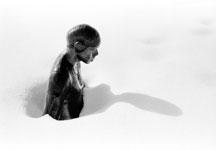
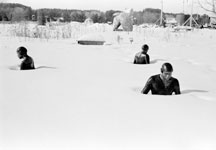
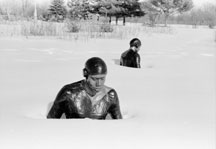
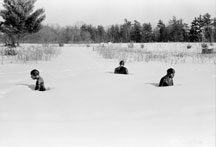
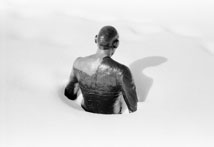
I never knew Michael Richards. I never met him or knew who he was. It happens, though, that I once stood bemused before one of his works without knowing it was his. It was on a clear cold winter day in Minnesota. The work was out in the middle of a field, half-buried in snow. The parts that were visible were so enigmatic that I was drawn to photograph them.
The title of the work is “Are You Down?” It was created and is still sited at the Franconia Sculpture Park, outside the rural town of Shafer, about 45 minutes northeast of Minneapolis/St. Paul. It appears to be made of bronze, but is actually resin/fiberglass–the intent now is to cast it in bronze, as a memorial. “Are You Down?” is a tableau of three nearly life-sized human figures. Three parachutists fallen from the sky, they sit disconsolate on the ground in what appear (once the snow has melted to reveal them) to be puddles of tar. Backs turned to one another, the figures form a triangle about twelve feet on a side. Within the triangle is a large bulls-eye flat on the ground, the target where the men had aimed to land. Their heads clad in close-fitting leather aviator helmets, their shirts torn from the drop, the figures represent three downed aviators from the storied, all-black Tuskegee Airmen’s Squadron of the Second World War, men whose images Richards (using himself as his model) returned to in his work obsessively, again and again. They speak not so much of the exhilaration of flight as of dreams of freedom crashed to Earth.
Michael Richards was killed by the plane that hit the south tower of the World Trade Center. He was in his studio on the 92nd floor, probably just preparing to leave for his day job as an art handler at a museum in the Bronx. Of the many blameless people annihilated that day, few can have meditated quite as much as this man did upon the quick rise and quicker fall of hope: a Jamaican, an immigrant, a black man, Richards knew something about the loneliness of exile, and the feeling of exclusion from the feast. It is no presumption to imagine he could taste it and that he must, at times, have had nothing to go on but his rage against an identity projected on him by apartheid.
There is another sculpture by Richards in resin and steel, one I have seen only in photographs. Its title is “Tar Baby vs. St. Sebastian” and its meaning, in light of 9/11, is terrible. Seeing it, it is impossible not to wonder by what compass Richards found his way across this life, or how the needle quivering in that compass could point him to create a work that would foretell his own death. The sculpture, over seven feet tall, is a standing figure of a single Tuskegee airman. The pose is almost Pharaonic. Where in old paintings the body of the martyred St. Sebastian bristles with a thicket of arrows, this figure is impaled instead by a swarm of fighter planes, stuck like darts thrown at an effigy. The irony of this sculpture is obvious even to people oblivious to art. It is oracular and crushing. Looking at it now, there is no escaping a feeling that there are more dimensions to reality than we are able to acknowledge without becoming in some way unhinged.
Science is embarrassed by what it can’t explain…it falls off a cliff. Faced with Michael Richards’s prophetic depiction of his own death, it can do little more than mumble, “It was a random thing, the clicking-past of numbers…the shrapnel of blind fate.” This work and the death of Michael Richards are a manifestation of a realm we are now for the most part closed off from, a realm not taken seriously (if it is even acknowledged by a modern to exist.) It is occult, a mystery we cannot penetrate. We cannot make our way into it with stethoscopes and rubble-sniffing dogs.
The specter of death–anyone’s death, one’s own, Richards’s–is awful to behold. Words stick in the throat; it is unspeakable. How does a building give way and collapse? How does a human? Joists buckle, columns snap. Struck a massive blow, the head’s last thought is that it is thinking its last thought, the sphincter feels it, the knowledge moves like voltage down the spinal cord, vertebrae buckling as the information races past to break the ankles. In the inferno that ensues, a man– two thousand eight hundred and twenty-four men and women–transmute into the mother carbon they were made from.
I didn’t know Michael Richards. I only know, from slight exposure to his work, a little of what it was like to be Michael Richards. We who still happen to be alive must let Richards know that his vision was real, that we saw it, and that we will preserve it.
